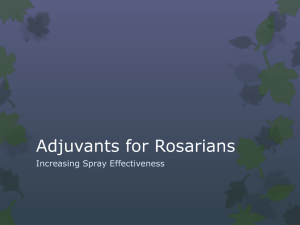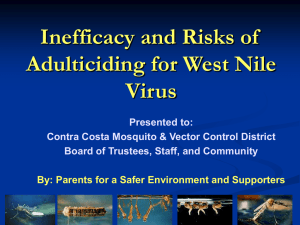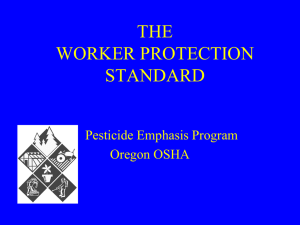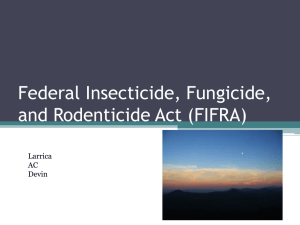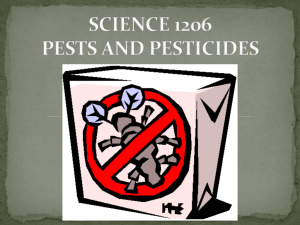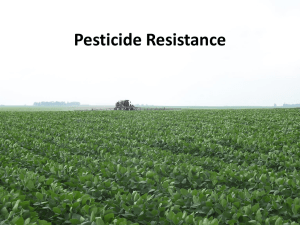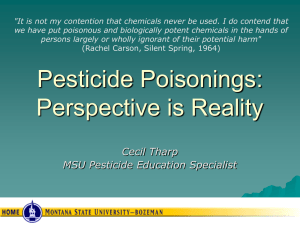OSHA Training, Pesticide Storage
advertisement
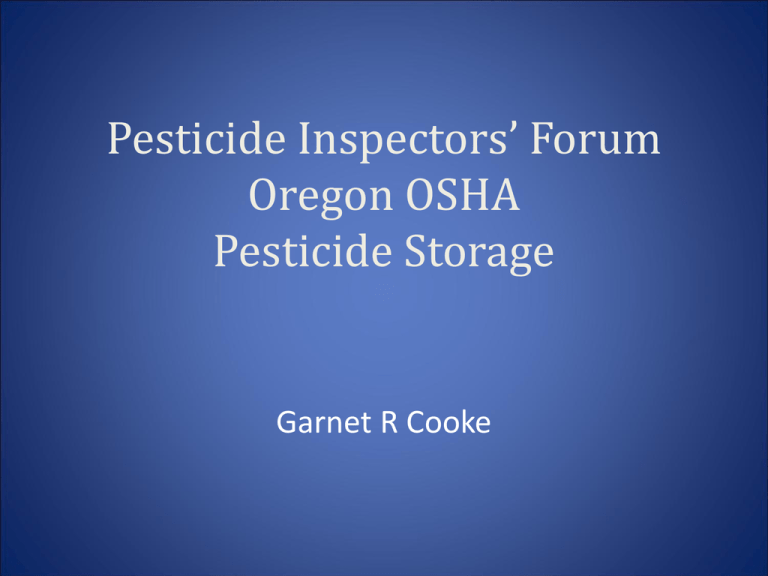
Pesticide Inspectors’ Forum Oregon OSHA Pesticide Storage Garnet R Cooke Unfortunately, all pesticide storage areas don’t look like this: Some look like this: Pesticide Storage Violations • 2009 – 38 out of 394 pesticide related violations • 2008 - 58 out of 479 pesticide related violations • 2007 - 23 out of 352 pesticide related violations • 2006 - 22 out of 275 pesticide related violations • 2005 – 23 out of 272 pesticide related violations Understanding Pesticide Storage Requirements – Why is it so hard? • • • • Multiple Agency Jurisdiction A universal seal of approval is not available Resources not readily accessible The belief that a good storage facility will cost lots of money • Difficulties finding solutions – Fear of calling attention to their facility – Don’t know who to ask Multiple Agency Jurisdiction • • • • • • • Oregon State Fire Marshal Oregon Department of Environmental Quality Oregon Department of Agriculture Oregon OSHA Local Building Codes US Environmental Protection Agency US Department of Homeland Security Multiple Agency Jurisdiction • Fire Marshal- Fire – exposures to responders, neighbors • DEQ- Spills on land, into water, up in smoke – ODFW & US Fish & Wildlife • • • • • ODA- Use not consistent with the label Oregon OSHA- employee exposures Building codes- tied to fire codes US EPA – following label US Homeland Security – not abetting terrorists Financial Costs & Pesticide Storage • Crop loss from inadvertent contamination in storage • Loss of pesticides due to fire • Environmental cleanup costs > $1000/hour • Loss of pesticides due to theft • Liability to neighbors • Equipment & structure loss • Insurance costs Pesticide Storage : First Steps • Growers need to conduct an inventory of the pesticides they have. • OR-OSHA has different regulations for general use pesticides and restricted use pesticides. – General Use: OAR 437-004-1680 (1-5) – Restricted Use: OAR 437-004-1680 (1-9) • If restricted use products are present the rule applies to all pesticides in storage (437-0041680(1-9). • Oregon OSHA looks for HAZARDS. OR-OSHA Pesticide Requirements General Use -Hazardous chemicals must be stored separately if they could cause hazardous reactions. Label by category Store Pesticides in Accordance with: Label, packaging, or MSDS Signage required for aluminum phosphide Follow the Label DO NOT STORE WITH FOOD Follow the Label Do NOT store within 100 feet of a well Following the Label Is hard to do when there Isn’t one. Control the Conditions Excessive freezing or heat may cause containers to break, melt, explode, and some pesticides to volatilize, drift, degrade Use exhaust fans to reduce temperature, remove dust and vapor to the outside Keep storage area cool well-ventilated, and dry Provide Adequate Lighting Lighting equal to 20 foot candles For reading labeling, spotting leaks, and cleaning up spills Use spark-proof fixtures and switches! OR-OSHA Pesticide Requirements General Use, cont. • Storage and removal of hazardous chemicals must not cause hazards to workers. Personal Protective Equipment • Do NOT store with pesticides • Store PPE away from Pesticides Decontamination • If pesticides are mixed adjacent to the pesticide storage area: – Soap – Water – Paper towels – Change of coveralls – 15 minute emergency eyewash when mixing Danger or Danger Poison pesticides. Emergency Eyewash AT MIX SITE ACCEPTABLE ACCEPTABLE / PORTABLE WHEN?? LABEL SAYS: DANGER DANGER POISON NOT ACCEPTABLE AT THE MIX SITE OR-OSHA Pesticide Requirements General Use - Notes • Electrical wiring must comply with Division 4/S • When dispensing a flammable or combustible liquid must comply with Division 4/H • Chemical storage must comply with appropriate state and local fire codes, NFPA 34 & Division 4/H OR-OSHA Pesticide Requirements Restricted Use Pesticides Lock the storage area to prevent access by unauthorized employees. RESTRICTED USE PESTICIDE REQUIREMENTS Store by category, not by the alphabet! RESTRICTED USE REQUIREMENTS Seal floors and shelves to prevent the absorbtion of hazardous chemicals Pesticide Storage Regulations Restricted Use When the storage area contains enough chemicals that a leak or spill could cause material to leave the confines of the building, there must be methods or means to contain the material. SPILLS: Prepare in Advance – Spills in Storage are Concentrates! PREPARE TRAIN PRACTICE LIMITS ECONOMIC IMPACT •Cleanup of some chemical spills may fall under Division 4/H (Haz Waste Op & Emergency Response) Spills • Containers can be damaged in transit and can leak, dissolve or be ripped. • Receivers should be aware of these problems. • Is there a plan for addressing these issues? Pesticide Spills PPE requirements vary depending on the type of spill. Growers need to know their limit: when is the spill too big to clean up safely. Do they have an outside contractor for cleanup? WA Ecology The 3 C’s Control - Contain - Clean up Good Stewardship? Encourage this: Confine Empty Containers When your travels reveal…… Find an Event Near Them Find an Event • Pesticides with the following ingredients will be accepted at no charge* • Chlorpyrifos (Dursban, Lorsban) 2, 4, 5-Trichlorphenol (Silvex, Fenoprop) Dicofol (Kelthane) Dinoseb (Dinitro, Premerge) Dyfonate (Fonofos) Bendiocarb (Ficam, Dycarb, Seedox) Azinphos methyl (Guthion) Chlorfenvinphos Carbofuran (Furadan) DDT Aldrin (Aldrex) Dieldrin (Dieldrite) Endosulfan (Thiodan, Thionex) Endrin (Endrix) Heptachlor (Chlorodane) Hexachlorobenzene Lead Arsenate (Gypsine, Security) Lindane (hexachlorocyclohexane, gamma-BHC) (Agrocide, Benexane) Mercury-based pesticides (e.g. mercurous chloride, mercuric chloride) Methoxychlor (Marlate, Chemform, Double-M) Mirex Phosphamdion (Dimecron) Toxaphene *The first 200 pounds of other pesticides will also be accepted at no charge. Additional quantities of other pesticides are accepted at $1.10 per pound. • Clackamas event: 18,351 pounds from 51 individuals Site Security • Is important if the location of the pesticide storage area is vulnerable to theft. • Encourage inventory awareness to report theft immediately of DANGER/POISON products. • Encourage pesticide storage areas to be in a secure location, report suspicious activity. • Keep the storage area locked. • Inform growers that they don’t want a product from their farm to be implicated in someone’s death. Plan ahead: WA Ecology After a Fire Contact the Pesticide Manufacturer For Assistance! Not all Haz Mat Contractors are familiar with pesticides! RESOURCES* • Designing Pesticide Storage buildings: see the order form in your handout. • Fire Codes: State Fire Marshal • Protecting groundwater: DEQ, Soil & Water Conservation Districts • Employee safety & Health: Oregon OSHA –call for a FREE consultation! • Old chemicals: – ODA, DEQ, Soil & Water Conservation Districts Photo Credits • Garnet Cooke, Pesticide Coordinator, OROSHA • National Pesticide Applicator Core Manual, Washington State University Extension: Chapter 8. • Virginia Tech Pesticide Program – http://www.pesticidepics.org/main.php


